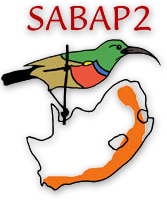

Welcome to the Southern African Bird Atlas Project! SABAP2 is a citizen science project that is driven by the energy of several hundred volunteers who are mapping the distribution of birds across several southern African countries. SABAP2 is the follow-up project to the Southern African Bird Atlas Project (SABAP1), which took place from 1987-1991. The second bird atlas project started on 1 July 2007 and is still growing. The project aims to map the distribution and relative abundance of birds in southern Africa and includes: South Africa, Lesotho, Botswana, Namibia, Mozambique, eSwatini, Zimbabwe, Zambia. To gather data, volunteers select a geographical ‘pentad’ on a map and record all the bird species seen within a set time frame, in order of species seen. This information is uploaded to the SABAP2 database and is used for research and analysis by several different agencies, including the South African National Biodiversity Institute, BirdLife South Africa, as well as academics and students at various universities.
Since 2007, more than 17 million records have been collected with about 2 million more being added each year. This valuable dataset is key to determining the conservation status of bird species, correctly assigning red-list status and establishing Important Bird and Biodiversity Areas, as well as forming the basis for informing environmental impact assessments. To gather valuable and useful data atlas coverage needs to be as thorough as possible. Ideally, each pentad should have a baseline of at least four comprehensive checklists (‘cards’), over several years and seasons. On the coverage maps this will mean a pentad turns ‘green’. Coverage intensity is scaled from yellow to dark purple, making it easy to identify which regions need more checklists.
Atlasing is fun and gives your birding a purpose! If you are keen to get involved, click on the ‘How to Participate’ tab or get in touch via our Facebook Group or Page and we’ll help you get started!
SABAP2 is based at the University of Cape Town and is funded by the FitzPatrick Institute of African Ornithology and the South African National Biodiversity Institute. The project is actively supported by BirdLife South Africa and BirdLasser.
*New* Birds of the Magaliesberg Biosphere, Wesson, J., Wesson, J., Balt, R., and Balt, M. , 2024
Birds of the Magaliesberg Biosphere., Wesson, J., Wesson, J. Balt, R and Balt, M. , 2024
Birds of Suikerbosrand Nature Reserve, Whittington- Jones C., Davidson I, 2024
The Woolly-necked Stork (Ciconia episcopus) has been split into two species, the African Woolly-necked Stork (Ciconia episcopus, 14836) and the Asian Woolly-necked Stork (Ciconia episcopus, 14837). Across the BirdMap family of projects (incl. SAFRING and CWAC), the original Woolly-necked Stork species reference number (77) will be retired, and the projects will continue with the two new species reference numbers that have been allocated.
On the BirdLasser app, you will notice an [x] prefixed to the 'old' species: [x] Woolly-necked Stork, starting from 25-03-2025. You will now need to change this species in the trip cards to the applicable one, African or Asian Woolly-necked Stork. Also, make sure you log the correct species going forward (and submitting to SABAP2).
Intermediate Egret has been split into 3 species, the Plumed, Medium and Yellow-billed.
The original species reference (60) has been retired and 3 new numbers assigned.